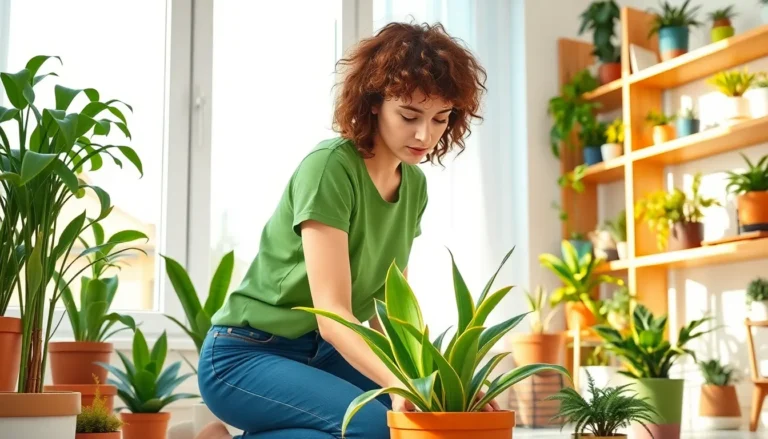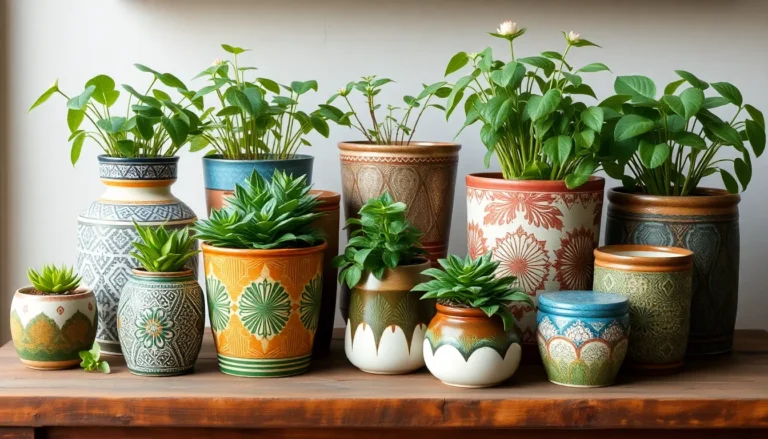Large leaf house plants aren’t just great for adding a splash of green to your home; they’re like the gentle giants of the plant world. With their broad leaves and dramatic presence, they can transform any room into a lush oasis. But identifying these leafy wonders can feel like a botanical game of hide and seek. Fear not! Whether you’re a seasoned plant parent or just starting your indoor jungle, this guide will help you decode the leafy mysteries lurking in your living space.
From the iconic monstera to the elegant philodendron, each large leaf plant has its quirks and charms. Understanding their unique features can make you the proud owner of a thriving green companion. So grab your magnifying glass and get ready to impress your friends with your newfound plant knowledge—who knew being a plant detective could be so rewarding?
Table of Contents
ToggleOverview of Large Leaf House Plants
Large leaf house plants capture attention with their striking foliage and substantial size. These plants not only bring a touch of nature indoors but also improve air quality. Popular species include Monstera, Philodendron, and Ficus, each featuring unique leaf characteristics.
Monstera plants are recognized for their iconic split leaves. They thrive in indirect sunlight and require moderate watering, making them suitable for various indoor environments. Philodendron varieties also display large, heart-shaped leaves. These plants adapt to low light conditions and prefer soil that remains slightly moist.
Ficus, particularly the Fiddle Leaf Fig, boasts broad, glossy leaves. It flourishes in bright, filtered light and demands careful watering. Other large leaf plants like Alocasia and Calathea feature intricate patterns and vibrant colors, enhancing any space’s aesthetic.
Large leaf plants often act as natural air purifiers. They absorb pollutants and release oxygen, contributing to a healthier indoor atmosphere. Knowing the specific needs of each plant type allows owners to provide optimal care, ensuring robust growth.
Identification becomes easier with the help of visual guides. Recognizing leaf shapes, patterns, and stem types aids in distinguishing between species. Resources abound online and in print, helping enthusiasts enhance their plant knowledge and care techniques effortlessly.
Understanding these characteristics transforms plant ownership into an engaging hobby. Embracing the unique charm of large leaf house plants leads to thriving green companions that enrich living spaces.
Common Types of Large Leaf House Plants
Identifying large leaf house plants includes recognizing specific species. Knowing their unique features aids in proper care and selection.
Ficus Lyrata (Fiddle Leaf Fig)
Ficus Lyrata stands out with its broad, violin-shaped leaves. This plant thrives in bright indirect light and requires regular watering. Leaf drop often occurs if the soil dries out excessively. It suits large spaces due to its size, often reaching heights of 6 feet or more. Regular rotation helps maintain an even growth pattern.
Monstera Deliciosa (Swiss Cheese Plant)
Monstera Deliciosa captivates with its distinct split leaves. This plant enjoys a warm, humid environment and benefits from bright but filtered light. Weekly watering keeps the soil slightly damp but avoid waterlogging. Mature plants can display dramatic growth, reaching 10 feet indoors. Propagation is easily achieved through stem cuttings.
Alocasia Amazonica (African Mask Plant)
Alocasia Amazonica features striking leaves shaped like arrows, adorned with vibrant venation. It thrives best in warm temperatures with high humidity levels. Watering should be consistent, allowing the top layer of soil to dry out between sessions. This plant can grow up to 3 feet tall. Its dramatic appearance makes it a focal point in any indoor setting.
Identifying Features of Large Leaf House Plants
Recognizing large leaf house plants involves understanding specific traits. Leaf shape and texture play critical roles in identification.
Leaf Shape and Texture
Distinct shapes characterize the leaves of large leaf house plants. Monstera Deliciosa features iconic split leaves, while Ficus Lyrata showcases broad, violin-like leaves. Texture varies as well; smooth surfaces on some leaves contrast with the rugged feel of others. Alocasia Amazonica displays arrow-shaped foliage that’s both striking and textured. Understanding these shapes and textures allows for accurate identification.
Growth Habit and Size
Growth habits greatly influence how large leaf house plants are recognized. Some species, like Philodendron, exhibit a climbing or trailing manner, while others, such as Fiddle Leaf Fig, grow upright and bushy. Size also varies significantly; some plants can reach several feet tall, while others remain more compact. Monstera can grow dramatically indoors, reaching impressive heights. Recognizing these growth patterns and size differences assists in proper identification.
Care Tips for Large Leaf House Plants
Large leaf house plants require specific care to thrive indoors. Ensure adequate light by placing them in spots that receive bright, indirect sunlight. Monstera prefers filtered light, while Fiddle Leaf Fig flourishes with more direct sunlight for at least six hours a day.
Humidity plays a crucial role in maintaining their health. Regular misting or using a humidifier keeps the environment optimal for plants like Alocasia, which thrives in high humidity. It’s important for owners to monitor humidity levels, especially during winter months when indoor air can be dry.
Watering frequency varies among species. Keeping the soil consistently moist without being soggy is vital. Philodendron typically requires less water compared to Monstera. Checking the top inch of soil can guide watering needs effectively.
Fertilize these plants during the growing season to support their growth. Using a balanced, water-soluble fertilizer every four to six weeks can enhance their vitality. Ensure not to fertilize during the winter months when these plants enter a dormancy phase.
Repotting these plants should occur every couple of years or when they become root-bound. Select a pot that allows for adequate drainage. Adding fresh potting mix replenishes nutrients and provides ample space for growth.
Pest control is essential for maintaining their health. Common pests include spider mites and aphids, which can be managed by inspecting leaves regularly and using neem oil as a natural pesticide. Observing for signs of distress involves checking for discoloration or wilting, which may indicate underlying issues.
Implementing these care tips fosters a thriving environment for large leaf house plants, promoting their growth and enhancing indoor spaces.
Large leaf house plants not only elevate the aesthetics of indoor spaces but also contribute to a healthier environment. By understanding their unique characteristics and care requirements, plant enthusiasts can confidently choose and nurture these stunning plants. Whether it’s the iconic Monstera or the elegant Fiddle Leaf Fig, each species brings its own charm and benefits. With the right knowledge and care, anyone can cultivate a thriving collection of large leaf plants that impresses both friends and family. Embracing this hobby can lead to a fulfilling journey in plant ownership.






